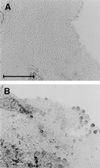The mosquito Anopheles stephensi limits malaria parasite development with inducible synthesis of nitric oxide
- PMID: 9576947
- PMCID: PMC20442
- DOI: 10.1073/pnas.95.10.5700
The mosquito Anopheles stephensi limits malaria parasite development with inducible synthesis of nitric oxide
Abstract
We have discovered that the mosquito Anopheles stephensi, a natural vector of human malaria, limits parasite development with inducible synthesis of nitric oxide (NO). Elevated expression of A. stephensi NO synthase (NOS), which is highly homologous to characterized NOS genes, was detected in the midgut and carcass soon after invasion of the midgut by Plasmodium. Early induction is likely primed by bacterial growth in the blood meal. Later increases in A. stephensi NOS expression and enzyme activity occurred at the beginning of sporozoite release. Circulating levels of nitrite/nitrate, end-products of NO synthesis, were significantly higher in Plasmodium-infected mosquitoes. Dietary provision of the NOS substrate L-arginine reduced Plasmodium infections in A. stephensi. In contrast, dietary provision of a NOS inhibitor significantly increased parasite numbers in infected mosquitoes, confirming that A. stephensi limits Plasmodium development with NO.
Figures





References
Publication types
MeSH terms
Substances
Associated data
- Actions
- Actions
- Actions
- Actions
- Actions
- Actions
- Actions
- Actions
- Actions
- Actions
- Actions
LinkOut - more resources
Full Text Sources

